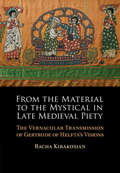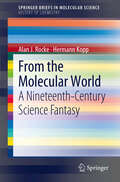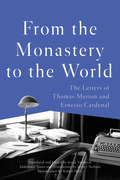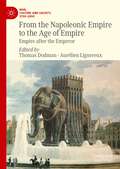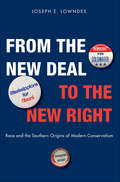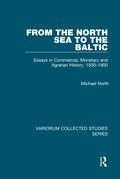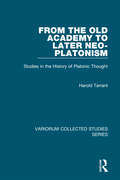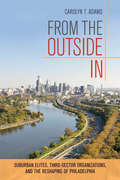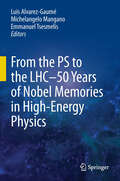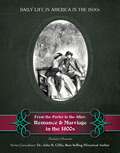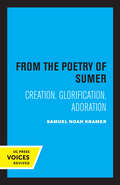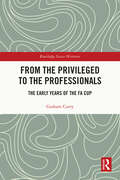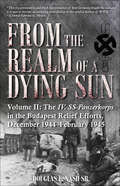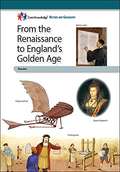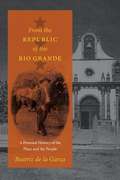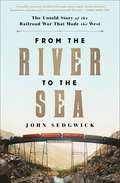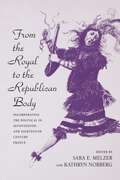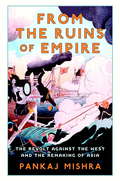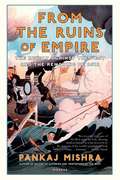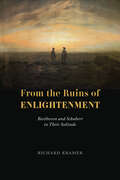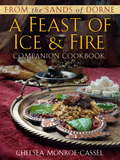- Table View
- List View
From the Material to the Mystical in Late Medieval Piety: The Vernacular Transmission of Gertrude of Helfta's Visions
by Racha KirakosianThe German mystic Gertrude the Great of Helfta (c.1256–1301) is a globally venerated saint who is still central to the Sacred Heart Devotion. Her visions were first recorded in Latin, and they inspired generations of readers in processes of creative rewriting. The vernacular copies of these redactions challenge the long-standing idea that translations do not bear the same literary or historical weight as the originals upon which they are based. In this study, Racha Kirakosian argues that manuscript transmission reveals how redactors serve as cultural agents. Examining the late medieval vernacular copies of Gertrude's visions, she demonstrates how redactors recast textual materials, reflected changes in piety, and generated new forms of devotional practices. She also shows how these texts served as a bridge between material culture, in the form of textiles and book illumination, and mysticism. Kirakosian's multi-faceted study is an important contribution to current debates on medieval manuscript culture, authorship, and translation as objects of study in their own right.
From the Molecular World
by Alan J. Rocke Hermann KoppHermann Kopp (1817-1892) is best remembered today as a historian of chemistry, but during his lifetime he was one of the most eminent chemists of his day, and one of the earliest pioneers of physical chemistry. Late in his career he wrote an endearing fantasy about personified molecules. Published in 1882, Aus der Molecular-Welt (From the Molecular World) portrayed the intimate details of what might actually be happening in the sub-microscopic world; the atoms and molecules we meet there have agency, personalities, sometimes even dialog. Filled with appealing tropes, humor, and whimsical asides, Kopp's short book provided an examination of the chemistry and physics of his day that was always light-hearted on the surface, but often surprisingly profound. Properly interpreted, the book provides a revealing tour of nineteenth-century debates concerning chemical theory. It is here translated into English, richly annotated, and equipped with an illuminating preface by a leading historian of chemistry. It provides entertaining reading to practicing chemists, as well as new insights to historians of science.
From the Monastery to the World: The Letters of Thomas Merton and Ernesto Cardenal
by Thomas Merton Ernesto CardenalThomas Merton and Ernesto Cardenal were both poets and priests, wholly committed to a life of spiritual contemplation which was never far from the gritty work that lead them to risk life and reputation in order to raise worldwide consciousness concerning issues of social justice and the abuse of human rights. From the Monastery to the World collects the complete correspondence between these spiritual men and dedicated activists, translated into English for the first time.The letters in this book, written between Merton and Cardenal from 1959–1968, give us fascinating insights into the early spiritual and political awakenings of eventual Sandinista and exponent of liberation theology Ernesto Cardenal, who was then a novice leaving the Trappist Monastery in Kentucky where he first met Merton. While making the long trip home to Nicaragua to build a utopian artist's commune on the Island of Solentiname, Cardenal rubs elbows with some of Latin America's greatest writers and artists of that time.In From the Monastery to the World, Cardenal is still a hungry pupil, years away from becoming the internationally renowned poet–statesman and Nicaraguan Minister of Culture. Here we see the poet and monk Thomas Merton as a wise, patient, and sometimes even humbled mentor, during the years when he was still shaping and collecting the raw materials for such writings as: "The Way of Chuang Tzu", "Raids on the Unspeakable", and "Conjectures of a Guilty Bystander".Merton and Cardenal's correspondence grants readers an audience to conversations between two men deeply connected by their vigorous endeavors toward spiritual freedom, voracious intellectual appetites, and artistic exploration despite the cultural differences, language barriers, and geographic distances which divide them.
From the Mouth of the Whale
by SjónShortlisted for The International IMPAC Dublin Literary Prize 2013 Shortlisted for the Independent Foreign Fiction Prize 2012'Sjón's novels are brilliant collisions of history and fable, psychology and fantasy' Chris Power, GuardianThe year is 1635. Iceland is a world darkened by superstition, poverty and cruelty. Men of science marvel over a unicorn s horn, poor folk worship the Virgin in secret and both books and men are burnt. Jónas Pálmason, a poet and self-taught healer, has been condemned to exile for heretical conduct, having fallen foul of the local magistrate. Banished to a barren island, Jónas recalls his exorcism of a walking corpse on the remote Snjáfjöll coast, the frenzied massacre of innocent Basque whalers at the hands of local villagers, and the deaths of three of his children.From the Mouth of the Whale is a magical evocation of an enlightened mind and a vanished age.
From the Napoleonic Empire to the Age of Empire: Empire after the Emperor (War, Culture and Society, 1750–1850)
by Thomas Dodman Aurélien LignereuxThis book explores imperial entanglements to reassess the Napoleonic Empire as a missing link—or at least an important chain—in the global and longue durée history of Empires. In recent years Napoleonic studies have, belatedly but resolutely, embraced the transnational historiographical turn, vastly expanding the field’s geographical scope. Its canonical chronological boundaries, on the other hand, appear increasingly narrow against this wider backdrop, giving the impression of a parenthetical, almost anachronistic aside from 1799 to 1815. What connects, and what doesn’t connect, the Napoleonic Empire to the Age of Empire, remains by and large an open question. Put another way, this book attempts to locate the Napoleonic empire in World History.
From the New Deal to the New Right
by Joseph E. LowndesThe role the South has played in contemporary conservatism is perhaps the most consequential political phenomenon of the second half of the twentieth century. The region's transition from Democratic stronghold to Republican base has frequently been viewed as a recent occurrence, one that largely stems from a 1960s-era backlash against left-leaning social movements. But as Joseph Lowndes argues in this book, this rightward shift was not necessarily a natural response by alienated whites, but rather the result of the long-term development of an alliance between Southern segregationists and Northern conservatives, two groups who initially shared little beyond opposition to specific New Deal imperatives. Lowndes focuses his narrative on the formative period between the end of the Second World War and the Nixon years. By looking at the 1948 Dixiecrat Revolt, the presidential campaigns of George Wallace, and popular representations of the region, he shows the many ways in which the South changed during these decades. Lowndes traces how a new alliance began to emerge by further examining the pages of theNational Reviewand Republican party-building efforts in the South during the campaigns of Eisenhower, Goldwater, and Nixon. The unique characteristics of American conservatism were forged in the crucible of race relations in the South, he argues, and his analysis of party-building efforts, national institutions, and the innovations of particular political actors provides a keen look into the ideology of modern conservatism and the Republican Party.
From the North Sea to the Baltic: Essays in Commercial, Monetary and Agrarian History, 1500-1800 (Variorum Collected Studies)
by Michael NorthThe Baltic in the early modern period has been called a 'Nordic Mediterranean'. In the studies collected here, Professor North is concerned to examine the ways in which this Baltic region became integrated into the international division of labour and the emerging world economy. The volume opens with a new introductory essay, and the first section then focuses on commodities exported to Western Europe - grain, timber, flax, hemp and other raw materials. The following studies examine how this ever growing bulk trade stimulated a flow of money and payments in the opposite direction, and led to the formation of the manorial economy and second serfdom in the grain-producing countries of the Baltic hinterlands.
From the Old Academy to Later Neo-Platonism: Studies in the History of Platonic Thought (Variorum Collected Studies)
by Harold TarrantThis volume collects a set of papers on ancient Platonism that span the nine centuries between Plato himself and his commentator Olympiodorus in the 6th century, many of them less easy to obtain. Much of the work is at the intersection of philosophy and literature, and a recurrent aim is to challenge existing orthodoxies and to suggest alternatives. Two further related aims are to encourage the rereading of Plato in the light of the later tradition, and the tradition in the light of influential passages of Plato. The articles are grouped here in three sections, dealing first with Socrates, Plato and the Old Academy, then with the Platonic revival and the 2nd century AD, and finally with later Neoplatonism.
From the Outside In: Suburban Elites, Third-Sector Organizations, and the Reshaping of Philadelphia
by Carolyn T. AdamsIn From the Outside In, Carolyn T. Adams addresses the role of suburban elites in setting development agendas for urban municipalities and their larger metropolitan regions. She shows how major nongovernmental, nonmarket institutions are taking responsibility for reshaping Philadelphia, led by suburban and state elites who sit on boards and recruit like-minded suburban colleagues to join them. In Philadelphia and other American cities, Third Sector organizations have built and expanded hospitals, universities, research centers, performing arts venues, museums, parks, and waterfronts, creating whole new districts that are expanding outward from the city's historic downtown. The author draws on three decades of scholarship on Philadelphia and her personal experience in the city's nonprofit world to argue that suburban elites have recognized the importance of the central city to their own future and have intervened to redevelop central city land and institutions. Suburban interests and state allies have channeled critical investments in downtown development and K-12 education. Adams contrasts those suburban priorities with transportation infrastructure and neighborhood redevelopment, two policy domains in which suburban elites display less strategic engagement. From the Outside In is a rich examination of the promise and difficulty of governance that is increasingly distinct from elected government and thus divorced from the usual means of democratic control within an urban municipality.
From the PS to the LHC - 50 Years of Nobel Memories in High-Energy Physics
by Luis Alvarez-Gaumé Emmanuel Tsesmelis Michelangelo ManganoThis collection of lectures and essays by eminent researchers in the field, many of them nobel laureates, is an outgrow of a special event held at CERN in late 2009, coinciding with the start of LHC operations. Careful transcriptions of the lectures have been worked out, subsequently validated and edited by the lecturers themselves. This unique insight into the history of the field includes also some perspectives on modern developments and will benefit everyone working in the field, as well as historians of science.
From the Parlor to the Altar: Romance and Marriage in the 1800s (Daily Life in America in the 1800s)
by Zachary ChastainWe're all here because of people who met and fell in love in the past! In the 1800s, most young men and women were bound by powerful traditions of family, church, and society that limited their choices in romance and marriage. As an economic and community-building institution, marriage options were traditionally controlled by the older generation. Marriages were often arranged by families, and the bride and groom's personal feelings for each other were much less important than they are today. But as in so many other ways, America was a new and more open society. Communities of people from different and diverse backgrounds were established in a new land, and young people came together in a freer, more open environment. Romantic love flourished in the America of the 1800s as it never had before, with a whole variety of courting and marriage customs, many of which we still cherish today.
From the Poetry of Sumer: Creation, Glorification, Adoration (Una's Lectures #2)
by Samuel Noah KramerThis title is part of UC Press's Voices Revived program, which commemorates University of California Press’s mission to seek out and cultivate the brightest minds and give them voice, reach, and impact. Drawing on a backlist dating to 1893, Voices Revived makes high-quality, peer-reviewed scholarship accessible once again using print-on-demand technology. This title was originally published in 1979.
From the Post Enron Accounting Scandals to the Subprime Crisis: A Financial History of the United States 2004–2006 (Financial History of the United States)
by Jerry W. MarkhamOriginally published in 2011, this volume examines the Enron-era scandals and several corporate governance issues that were raised as a result of these scandals. It then describes developments in the securities and derivatives markets, covering hedge funds, venture capital, private equity and sovereign wealth funds.
From the Privileged to the Professionals: The Early Years of the FA Cup (Routledge Soccer Histories)
by Graham CurryThis book is concerned with the early years of the Football Association Challenge Cup – more commonly known as the FA Cup – examining events from its inception in 1871–2 to the beginning of the Football League in 1888–9. The work is underpinned by the figurational sociology of Norbert Elias, employing his ideas around the European 'civilising process', power and lengthening chains of human interdependency. Most of all, the majority of the text has been compiled using primary source material, such as newspaper reports and the minutes of the Football Association, which encourages original and unique additions to the body of knowledge. There exist no comparable offerings on the time period involved, with the book providing a distinct perspective for scholars and non-specialists alike. The initial years of the competition were dominated by teams consisting mainly of upper-middle-class southern amateurs. However, by the early 1880s, they were supplanted by men who were initially covert– and eventually overt – professionals, many of whom hailed from Scotland, but mainly represented clubs from Lancashire and the West Midlands. The FA Cup, despite losing some of its allure when compared to competitions such as the UEFA Champions League, still retains a magic of its own in the English football calendar.
From the Ptolemies to the Romans
by Andrew MonsonThis book gives a structured account of Egypt's transition from Ptolemaic to Roman rule by identifying key relationships between ecology, land tenure, taxation, administration and politics. It introduces theoretical perspectives from the social sciences and subjects them to empirical scrutiny using data from Greek and Demotic papyri as well as comparative evidence. Although building on recent scholarship, it offers some provocative arguments that challenge prevailing views. For example, patterns of land ownership are linked to population density and are seen as one aspect of continuity between the Ptolemaic and Roman period. Fiscal reform, by contrast, emerges as a significant mechanism of change not only in the agrarian economy but also in the administrative system and the whole social structure. Anyone seeking to understand the impact of Roman rule in the Hellenistic east must consider the well-attested processes in Egypt that this book seeks to explain.
From the Realm of a Dying Sun: The IV. SS-Panzerkorps in the Budapest Relief Efforts, December 1944–February 1945
by Douglas E. Nash Sr.“A veritable tour de force of Eastern Front armored combat replete with slashing counterattacks, defending to the last man, and overcoming odds.” —Mark J. Reardon, author of Victory at MortainOn Christmas Eve 1944, the men of the IV. SS-Panzerkorps and its two divisions—the 3rd SS Panzer Division “Totenkopf” and the 5th SS Panzer Division “Wiking”—were eagerly anticipating what the holiday would bring, including presents from home and perhaps sharing a bottle of schnapps or wine with their comrades.This was not to be, for that very evening, the corps commander, SS-Obergruppenführer Herbert Otto Gille, received a telephone call notifying him that the 35,000 men of his corps would begin boarding express trains the following day that would take them from the relative quiet of the Vistula Front to the front lines in Hungary, hundreds of kilometers away. Their mission: Relieve Budapest! Thus would begin the final round in the saga of the IV. SS-Panzerkorps. In Hungary, it would play a key role in the three attempts to raise the siege of that fateful city. Threatened as much by their high command as by the forces of the Soviet Union, Gille and his troops overcame seemingly insurmountable obstacles in their attempts to rescue the city’s garrison, only to have their final attack called off at the last minute. At that moment, they were only a few kilometers away from the objective towards which they had striven for nearly a month. After the relief attempt’s failure sealed the fate of hundreds of thousands of Hungarians and Germans, the only course of action remaining was to dig in and protect the Hungarian oilfields as long as possible.
From the Renaissance to England's Golden Age
by Core FoundationFrom the Renaissance to England's Golden Age is a single book that, in three sections-on the Renaissance, the Reformation, and England's Golden Age-tells the story of a time of dynamic political, religious, and artistic change in Europe that had far-reaching consequences for the shaping of the modern world. Young readers are introduced to great Renaissance artists (including Raphael, Michelangelo, and Leonardo da Vinci); key figures of the Reformation (including Gutenberg, Martin Luther, and John Calvin); Copernicus and Galileo; England's Henry VIII, Queen Elizabeth I, Oliver Cromwell, Charles II, and more.
From the Republic of the Rio Grande: A Personal History of the Place and the People
by Beatriz de la GarzaThe Republic of the Rio Grande had a brief and tenuous existence (1838–1840) before most of it was reabsorbed by Mexico and the remainder annexed by the United States, yet this region that straddles the Rio Grande has retained its distinctive cultural identity to the present day. Born on one side of the Rio Grande and raised on the other, Beatriz de la Garza is a product of this region. Her birthplace and its people are the subjects of this work, which fuses family memoir and borderlands history. From the Republic of the Rio Grande brings new insights and information to the study of transnational cultures by drawing from family papers supplemented by other original sources, local chronicles, and scholarly works. De la Garza has fashioned a history of this area from the perspective of individuals involved in the events recounted. The book is composed of nine sections spanning some two hundred years, beginning in the mid-1700s. Each section covers not only a chronological period but also a particular theme relating to the history of the region. De la Garza takes a personal approach, opening most sections with an individual observation or experience that leads to the central motif, whether this is the shared identity of the inhabitants, their pride in their biculturalism and bilingualism, or their deep attachment to the land of their ancestors.
From the River to the Sea: The Untold Story of the Railroad War That Made the West
by John SedgwickA sweeping and lively history of one of the most dramatic stories never told—of the greatest railroad war of all time, fought by the daring leaders of the Santa Fe and the Rio Grande to seize, control, and create the American West. It is difficult to imagine now, but for all of its cloudy peaks and gorgeous coastline, the American West might have been barren tundra as far as most Americans knew well into the 19th century. While gauzy advertising promotions of the West as a paradise on earth intrigued citizens in the East and Midwest, many believed the journey too hazardous to be worthwhile—until 1869, when the first transcontinental railroad changed the face of transportation. Railroad companies soon became the rulers of western expansion, choosing routes, creating brand-new railroad towns, and building up remote settlements like Santa Fe, Albuquerque, San Diego, and El Paso into proper cities. But thinning federal grants left the routes incomplete, an opportunity that two brash new railroad men, armed with private investments and determination to build an empire across the Southwest clear to the Pacific, soon seized, leading to the greatest railroad war in American history. In From the River to the Sea, bestselling author John Sedgwick recounts, in vivid and thrilling detail, the decade-long fight between General William J. Palmer, the Civil War hero leading the &“little family&” of his Rio Grande, coming down from Denver, hoping to showcase the majesty of the Rockies, and William Barstow Strong, the hard-nosed manager of the corporate-minded Santa Fe, venturing west from Kansas. What begins as an accidental rivalry when the two lines cross in Colorado soon evolves into an all-out battle as each man tries to outdo the other—claiming exclusive routes through mountains, narrow passes, and the richest silver mines in the world; enlisting private armies to protect their land and lawyers to find loopholes; dispatching spies to gain information; and even using the power of the press and incurring the wrath of the God-like Robber Baron Jay Gould—to emerge victorious. By the end of the century, one man will fade into anonymity and disgrace. The other will achieve unparalleled success—and in the process, transform a sleepy backwater of thirty thousand called &“Los Angeles&” into a booming metropolis that will forever change the United States. Filled with colorful characters and high drama, told at the speed of a locomotive, From the River to the Sea is an unforgettable piece of American history—and one of the last great untold tales of the Wild West.
From the Royal to the Republican Body: Incorporating the Political in Seventeenth- and Eighteenth-Century France
by Sara E. Melzer Kathryn NorbergIn this innovative volume, leading scholars examine the role of the body as a primary site of political signification in seventeenth- and eighteenth-century France. Some essays focus on the sacralization of the king's body through a gendered textual and visual rhetoric. Others show how the monarchy mastered subjects' minds by disciplining the body through dance, music, drama, art, and social rituals. The last essays in the volume focus on the unmaking of the king's body and the substitution of a new, republican body. Throughout, the authors explore how race and gender shaped the body politic under the Bourbons and during the Revolution. This compelling study expands our conception of state power and demonstrates that seemingly apolitical activities like the performing arts, dress and ritual, contribute to the state's hegemony. From the Royal to the Republican Body will be an essential resource for students and scholars of history, literature, music, dance and performance studies, gender studies, art history, and political theory.
From the Ruins of Empire
by Pankaj MishraThe Victorian period, viewed in the West as a time of self-confident progress, was experienced by Asians as a catastrophe. As the British gunned down the last heirs to the Mughal Empire, burned down the Summer Palace in Beijing, or humiliated the bankrupt rulers of the Ottoman Empire, it was clear that for Asia to recover a vast intellectual effort would be required.Pankaj Mishra's fascinating, highly entertaining new book tells the story of a remarkable group of men from across the continent who met the challenge of the West. Incessantly travelling, questioning and agonising, they both hated the West and recognised that an Asian renaissance needed to be fuelled in part by engagement with the enemy. Through many setbacks and wrong turns, a powerful, contradictory and ultimately unstoppable series of ideas were created that now lie behind everything from the Chinese Communist Party to Al Qaeda, from Indian nationalism to the Muslim Brotherhood.Mishra allows the reader to see the events of two centuries anew, through the eyes of the journalists, poets, radicals and charismatics who criss-crossed Europe and Asia and created the ideas which lie behind the powerful Asian nations of the twenty-first century.
From the Ruins of Empire: The Revolt Against the West and the Remaking of Asia
by Pankaj MishraA little more than a century ago, independent thinkers across Asia sought to frame a distinct intellectual tradition that would inspire the continent's rise to dominance. Yet this did not come to pass, and today those thinkers--Tagore, Gandhi, and later Nehru in India; Liang Qichao and Sun Yat-sen in China; Jamal al-Din al-Afghani and Abdurreshi al Ibrahim of the Ottoman Empire--are seen as outsiders within the main anticolonial tradition. But as Pankaj Mishra demonstrates in this enthralling portrait of like minds, Asia's revolt against the West is not the one led by faith-fired terrorists and thwarted peasants; rather, it is rooted in the ideas of these once renowned intellectuals. Now, when the ascendency of Asia seems possible as never before, From the Ruins of Empire is as necessary as it is timely--a book indispensable to our understanding of the world and our place in it.
From the Ruins of Enlightenment: Beethoven and Schubert in Their Solitude
by Richard KramerRichard Kramer follows the work of Beethoven and Schubert from 1815 through to the final months of their lives, when each were increasingly absorbed in iconic projects that would soon enough inspire notions of “late style.” Here is Vienna, hosting a congress in 1815 that would redraw national boundaries and reconfigure the European community for a full century. A snapshot captures two of its citizens, each seemingly oblivious to this momentous political environment: Franz Schubert, not yet twenty years old and in the midst of his most prolific year—some 140 songs, four operas, and much else; and Ludwig van Beethoven, struggling through a midlife crisis that would yield the song cycle An die ferne Geliebte, two strikingly original cello sonatas, and the two formidable sonatas for the “Hammerklavier,” opp. 101 and 106. In Richard Kramer’s compelling reading, each seemed to be composing “against”—Beethoven, against the Enlightenment; Schubert, against the looming presence of the older composer even as his own musical imagination took full flight.From the Ruins of Enlightenment begins in 1815, with the discovery of two unique projects: Schubert’s settings of the poems of Ludwig Hölty in a fragmentary cycle and Beethoven’s engagement with a half dozen poems by Johann Gottfried Herder. From there, Kramer unearths previously undetected resonances and associations, illuminating the two composers in their “lonely and singular journeys” through the “rich solitude of their music.”
From the Sands of Dorne: A Feast of Ice & Fire Companion Cookbook
by Chelsea Monroe-CasselPrepare your palette for more than a dozen all-new recipes in this eBook-exclusive companion to the official Game of Thrones cookbook! Discover the tastes of Dorne, including one dish from The Winds of Winter, the highly anticipated next chapter of George R. R. Martin's beloved series, A Song of Ice and Fire. The most culturally distinct region of the Seven Kingdoms, Dorne is the sun-soaked desert land characterized by its unique customs and brash resistance to the Iron Throne. The Dornish people are known for their bold passions--perhaps best exemplified by the Red Viper himself, Oberyn Martell--and this fiery temperament has yielded a perfect pairing: their delicious cuisine. Packed with fresh flavor, zesty seasonings, and plenty of heat, this eclectic sampling of Southern delights can be enjoyed all year round, with savory fare to warm your bones in Winterfell and frozen desserts to help you keep cool in Sunspear. Inside, you'll find: * Succulent starters: Lemon-Egg Soup; Spicy Shrimp; Roasted Chickpeas. * Mediterranean-style mains: Lamb with Honey, Lemon, and Fiery Peppers; Eggs and Spicy Sausage; Green Peppers Stuffed with Cheese; Spicy Flatbread. * Tasty treats: Blood-Orange Granita; Candied Kumquats; Figs Stuffed with Nuts. With all the imagination, authenticity, and tongue-in-cheek humor that won A Feast of Ice and Fire a cult following, From the Sands of Dorne is an oasis for foodies everywhere.
